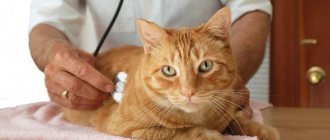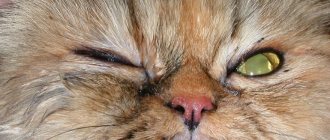In this article, we are going to explain the various causes of bumps on a cat's neck. We will learn about the role of the lymph nodes as part of the immune system and learn to identify tumors that will require veterinary consultation as they may be caused by an infection or tumor. Therefore, whether the lump on the neck hurts or not, we should consult a veterinarian.
If you're wondering why your cat has a lump on its neck, whether soft or hard, read on to find out the root causes and see a professional.
The cat has a lump under his jaw
The first thing to consider when explaining why a cat has a lump on its neck is the presence of submandibular lymph nodes. These ganglia are part of the immune system, so their function is to protect the body. If we notice that our cat has a lump on her neck, this may be inflammation of these nodes due to some pathological process.
© shutterstock
If the cat's immune system manages to control it, symptoms will no longer appear or they will be mild, such as mild discomfort or a slight fever. In other cases, the body cannot stop the pathogens and the disease develops, in which case we will need to help the cat with treatment, which, after diagnosis, will be prescribed to us by the veterinarian. Increased nodule size may be present in multiple diseases, hence the importance of diagnosis.
First aid and treatment for cats
You cannot begin treatment without making an accurate diagnosis. The pathogenesis of diseases is so different that carrying out any therapeutic measures may not have a therapeutic effect, but lead to irreversible consequences.
For different diseases and in different phases, completely different procedures are indicated, for example, warm compresses and cooling ones, or tight bandages and gentle ones.
If it is not possible to quickly see a doctor, then you can help the animal according to the main principle of doctors - do no harm:
- provide the four-legged with peace;
- if there is a violation of integrity, lubricate the area with syntomycin emulsion, tetracycline ointment or any other antibiotic-based ointment;
It is forbidden:
- apply bandages (tight, soft, etc.);
- cover infected wounds with dry powders such as streptocide;
- apply massage, rubbing and irritating ointments;
- apply cold and heat;
- postpone visiting the doctor.
Subcutaneous lumps in cats
Any subcutaneous lump, that is, under the skin that is not a ganglion, can have various origins and should be checked immediately by a veterinarian if we want to know why the cat has a lump on its neck.
In general, a hard lump on a cat's neck could be a cyst or tumor. By taking a sample from the inside, the veterinarian can determine its nature and, if it is cancer, whether it is benign or malignant. It is important to remember that if a cat has a lump in its throat, as we see it growing on the outside, it can grow inward, which can endanger its life by interrupting the flow of oxygen.
On the other hand, a soft lump on a cat's neck could be an abscess, which is a collection of pus in a cavity under the skin. These balls usually form after being bitten by another animal, so they are more likely to appear in whole venting cats who are about to fight for territory and mates. Animals have several bacteria in their mouths that, when bitten, remain in the wound. The cat's skin heals very easily, but bacteria remaining inside can cause an infection under the skin, which is the cause of the abscess.
Treatment of tumors is based on diagnosing their type and determining the presence of metastases, that is, whether the primary tumor has migrated throughout the body and affects other areas. You can choose removal surgery, chemotherapy or radiation therapy, depending on each individual case. In turn, abscesses require antibiotics, disinfection and, most difficult, drainage until they close.
Diagnosis by the appearance of the lump
The discovery of a lump can occur accidentally (while playing or stroking an animal) or due to symptoms of anxiety. If the lump doesn't bother your cat, it can grow slowly and then even disappear on its own without being noticed.
If the animal is worried, licks its paw or gnaws, tries to scratch it on objects, that is, pays increased attention to the place of pathology, then an examination should be carried out immediately.
If you have no experience in diagnosing diseases, it is very difficult even for a specialist to determine the course of the process and make a diagnosis by appearance (visually).
Diagnostic methods such as:
- palpation (palpation to determine the temperature of the local lesion and density, consistency);
- X-ray examination (to diagnose osteochondrodysplasia and other disorders in joints and bones);
- surgical opening of the local lesion.
Visually, pathology can be detected if the lump has its own character.
Soft
By palpation you can determine the density and degree of softness of the tissue. It should be taken into account that over time and the process, everything can change. For example, with a fresh hematoma, fluctuation is first felt (blood goes beyond the boundaries of the vessel and accumulates in the cavity or itself forms a cavity between muscle tissue or ligaments), skin tension and pain.
If microflora is introduced into the process, an abscess is formed. At the initial stage it is hard, then it becomes soft and the final stage will be self-opening with the expiration of purulent masses.
Soft swelling may be due to lymphatic exterovasation. In this case, the lower parts will be wider than the upper borders. If the process is left unattended, the tissues will become denser.
Solid
If, upon palpation, the lump is determined to be hard and the cat is a Scottish Fold, then osteochondrodysplasia (OCD) can be suspected. In this case, the bump may initially appear on one paw, or maybe on both at the same time. Exostases most often appear in the heel area. The skin on them loses its fur and may become ulcerated.
Hard formation also occurs with osteitis (inflammation of bone tissue). As a rule, this occurs in places not protected by soft tissues with damage to the periosteum.
Hard lumps occur as the end result of ruptures and sprains of ligaments, tendons, tendon sheaths (tendinitis and tendovaginitis) and muscles.
The aseptic reactive process leads to the proliferation of connective tissue and its compaction. It will feel hard to the touch. The process will be preceded by functional disorders (the cat will not be able to lean on its paw or will limp).
Black
Darkening of the skin may indicate an old process. If the lump has developed due to a hematoma, then the clotted blood will also give a dark blue or black color.
Red
The red color of the soft lump may indicate fresh oozing of blood. If the integrity of the blood vessels is broken through thin skin, the abrasion will have a pink tint, which will darken over time.
No wool
There may be no fur at the site of the bump if mechanical damage causes the pathology or if the cat constantly licks the area that bothers it.
If the process becomes purulent, then lysis of the hair follicles provokes hair loss and the area becomes bald.
Purulent
This process prior to disruption of integrity is partially described for soft cones. If the tissues have already been lysed and the pus comes out, then difficulties may arise in the sense that there may be “pockets” that will hold purulent masses.
The process cannot be ignored. The microflora of pus can be very aggressive.
Absorbed into the blood, it causes sepsis. During a purulent process, special attention should be paid to the general condition of the body and be sure to measure the temperature. If the readings are elevated, you should consult a doctor immediately.
The lump is bleeding
Moist and wet processes with leakage of lymph and blood can occur in both acute and chronic processes.
Disruption of the blood supply to a certain area of tissue causes the sweating of cellular elements outside the vessels.
The process can be complicated if the inflamed area is contaminated with pathogenic microflora. In this case, purulent processes are possible. Help should be provided immediately.
On the joint
If a lump has formed on a joint or near the articular surface, then inflammatory processes of the cartilaginous surfaces of the joints, tendons and tendon sheath, ligaments and bones are possible.
The lump will be dense. Impaired limb function may be observed, or the process may proceed without it.
Lump on a cat's neck as a reaction to a vaccine
We've looked at the most likely reasons why a cat has a ball in its neck, but also a type of tumor called fibrosarcoma can develop as a secondary reaction to the vaccine, especially in feline leukemia. Although the injections are usually in the withers area, the injection is located higher and we may notice a small nodule in the neck associated with inflammation. It should resolve within 3-4 weeks, but if it does not, chronic inflammation can lead to fibrosarcoma.
Surgery to remove it can be difficult because it is a very invasive tumor. For this reason, some professionals recommend using vaccines related to fibrosarcoma of the extremities, since this way they can be amputated in the event of a tumor.
We should also be aware that inflammation and even an abscess may occur as a side reaction in the inoculated area of any injection.
© shutterstock
Risk factors
In the vast majority of cases, owners of older animals encounter neoplasms on the withers and neck of cats. The appearance of soft cones and balls is due to the natural aging of the animal’s body. Risk factors for this:
- The pet is over 8 years old;
- Endocrine disorders;
- Obesity;
- Presence of parasites.
Only a veterinarian can accurately identify the nature of the lump, the cause of its appearance and suggest treatment methods. Self-medication in the presence of formations in pets is not allowed.
Lump on cat's neck due to thyroid gland
Finally, another explanation for why our cat has a lump on her neck could be an increase in the size of the thyroid gland, which is located in the neck and in some cases can be felt. This increase in volume usually occurs due to a benign tumor and consequently leads to excess secretion of thyroid hormones, which cause hyperthyroidism, which affects the entire body.
An affected cat will exhibit symptoms such as hyperactivity, increased hunger and thirst, but thinning, vomiting, poor hair coat, and other rather nonspecific symptoms. It can be detected with a hormonal test and treated with medications, surgery, or radioactive iodine.
Prevention and hygiene of paws
Quite often you can see a cat washing itself. She licks her paws thoroughly. Cat saliva contains the enzyme lysozyme, which has a pronounced antiseptic property. It is this substance that ensures the hygiene of the paws and all places that the animal licks.
If an animal visits the street, it is a good idea to wash its paws with lukewarm water and wipe with a napkin. If the walk happened in the rain, then you should wash the dirt more thoroughly.
Some owners limit themselves to wiping their paws with special wet, scented wipes. This cannot be done. Such napkins are impregnated not only with “perfume” but also with other substances, and the animal, by licking its paws, can swallow the remains.
The basis of lump prevention is inspection and palpation. When playing or stroking an animal, you can always notice on or under the skin:
- seals;
- wounds;
- areas of skin without fur;
- cones;
- growths.
Any foreign body that is not familiar to the animal should alert you. While observing an animal, it is easy to spot a place of increased interest. It is necessary to immediately examine it to identify the cause.
A timely visit to a specialist will help identify the pathological process at the initial stages, establish a diagnosis and provide timely, qualified assistance.
The cat has a bump on his face
Finally, once we've identified the most common reasons why a cat has a lump on its neck, we'll see why lumps can appear on their face as well. The cancer, squamous cell carcinoma, can cause nodular lesions, as well as the less common disease cryptococcosis.
Both require veterinary treatment. Cryptococcosis with antifungal drugs, as it is a disease caused by a fungus, and carcinoma can be operated on. As we can see, it is very important to contact a veterinarian as soon as possible in order to begin treatment as early as possible to avoid complications.
Causes and symptoms of lumps
A cat's lump under the skin can be malignant or benign. In the first case, the pet should be prescribed treatment as soon as possible, but it may not bring a positive result.
But the lump can also be a benign neoplasm. In this case, there is no need to panic, but it is better to show the cat to the veterinarian as soon as possible so that he can do the necessary research.
If a cat has a lump, this does not mean that the pet is experiencing pain or stress - often the lumps are painless.
Lumps can be very painful - most often this indicates some kind of disease. Even if the lump is not painful and benign, even this can significantly worsen the animal’s life. It is especially dangerous if the lump occurs on the back: this can lead to blockage of blood vessels, blood and oxygen do not reach the organs, and this condition can result in paralysis of the limbs or death.











